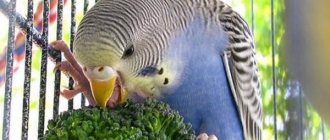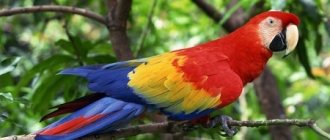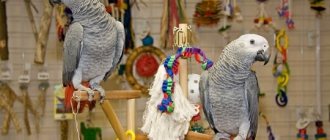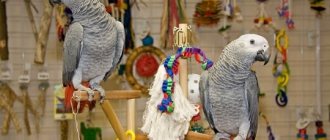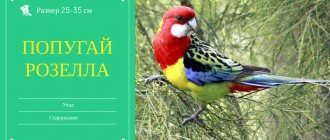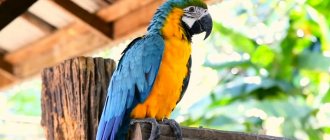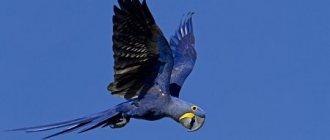The large tropical Amazon parrot is just a godsend for anyone who dreams of an extraordinary bird. The Amazon stands out among parrots for its particular liveliness, free behavior, and impulsiveness. You can expect anything from him.
There are two and a half dozen species of the Amazon genus, and they differ from each other in minor details. How to recognize what species a particular bird belongs to? What is the lifestyle of Amazon parrots in nature? Are there any difficulties in keeping an original pet at home, and what should you take care of before purchasing? You will learn about all this by reading the article.
Origin of the species and description
Photo: Amazon Parrot
Amazons are not just a species, but an entire genus of parrots. It includes 24-26 species, depending on the choice of classification. All Amazons are similar to each other, and only a specialist who knows certain marks and marks on parrots that indicate their species can distinguish one species from another.
The most common types of Amazons include:
- blue-fronted Amazon;
- Jamaican Black-billed Amazon;
- white-fronted Amazon;
- yellow-necked Amazon;
- red-tailed Amazon;
- blue-capped Amazon;
- royal amazon;
- Cuban Amazon;
- soldier's Amazon.
Video: Amazon Parrot
Amazons have evolved alongside people, largely thanks to this, these parrots are easily tamed, easily imitate human speech, love to play and be close to people. All types of Amazons are capable of living in apartment conditions.
Also included in the subfamily of true parrots are:
- bristle-headed parrots;
- fig parrots;
- rosella parrots;
- blunt-tailed parrots;
- neotropical parrots.
These parrots acquired in the course of evolution quite large sizes and the ability to onomatopoeize. Most often, they have a bright, memorable color and natural curiosity, thanks to which the birds learn quickly.
How to choose a chick
It is better to buy a parrot from a nursery. Suitable age is 4-6 months. The price depends on the type of Amazon and its abilities. In European countries, a chick costs about $500-700. For some individuals they can ask for 1000-1200 dollars.
When purchasing from Amazon, you should make sure that the parrot is banded and healthy. The parrot's good health is evidenced by even, dense plumage, clear, clean eyes, and measured breathing. The chick must remain calm when seeing people and make contact.
Amazon will be an ideal pet for exotic lovers. This parrot has many advantages, including beautiful appearance and the ability to speak.
Appearance and features
Photo: What does an Amazon parrot look like?
Amazons are large birds with a dense build. Their body length from head to tail is 25-45 cm, both in females and males. The color is green with various shades. Depending on the species, parrots have small red or yellow spots on various parts of the body. For example, spots may be at the base of the wings, near the eyes, on the chest or tail.
Some species of parrots also have wing speculum - small white spots on the inside of the wings. The beak of Amazons is large and strong, of medium length and rounded in shape. The beak forms a sharp rib. Thanks to this beak, Amazons can easily deal with hard food, crack a nut, or injure an offender.
Compared to other parrots, the Amazon's wings are short - they do not reach the end of the wing. The weight of such a parrot can reach 500 grams, although birds usually weigh less in the wild.
The age of an Amazon can be determined in a very specific way - by the color of the eye. Young Amazons have a grayish tint to the iris, and in adult birds that have reached the age of three, the iris becomes brown or even brown. After three years of age, it is difficult to determine how old a particular bird is - this is done by specialists.
Females and males do not have sexual dimorphism, and even professional ornithologists sometimes find it difficult to say who is in front of them: a female or a male. To determine gender, it is worth waiting until the mating season, where females and males have radically different behavior.
Breeding at home
If a couple is purchased for the purpose of future offspring, then it is important for a novice breeder to immediately create conditions suitable for wedding events.
How to distinguish a female from a male
An ordinary breeder cannot determine the sex of a bird. As a rule, only an experienced ornithologist can do this. However, based on indirect signs, it can be assumed which of the birds is male and which is female. Boys usually have a more massive body, a spherical head and a wide neck. But all these landmarks are only of relative importance, since aging females look approximately like young males.
Matching
A pair for Amazon can be ordered from breeders, found on the Internet, or purchased independently. Before allowing your partner near your pet, you must be completely sure of the following:
- the bird has no birth defects;
- the parrot is not suffering from colds at the moment;
- the age of the partner parrot is no more than 40 years;
- conditions for the alimony transfer of chicks.
Marriage period and creating conditions for it
To fully organize the mating season of birds, you should know the needs of winged birds during this period:
- Vitamins: add special dietary supplements to the food that promote a full hormonal rise in both birds;
- In nature, mating males need a large space for dancing, attracting a partner for the purpose of courtship - for this, the best option would be an aviary or a spacious room with free corners - birds often sit on them for a short respite;
- The most active peak of sexual play occurs from February to June. At the beginning of July, the female will lay her first clutch - for this it is necessary to create a cozy nest, protected from prying eyes on all sides. Otherwise the bird will not sit in it.
- During the period of hormonal activity and feeding chicks, birds can become. aggressive, so it is better to arrange the marriage house away from children and pets;
On average, the female sits on the clutch for 3–4 weeks, after which 1–3 chicks are born. In the wild, their number reaches up to 6. In nature, the male feeds the female and offspring while she is in the clutch. You should not interfere with the instinctive impulses of the bird - you can quarrel between the pair, and this can lead to the death of the litter.
The growing chicks are initially under parental care. The mother does not allow strangers near them. When the young parrots begin to fly after the next 8 to 10 weeks, bird owners should consider supplementing their chicks. Teenagers can be sold after another 1–2 weeks of supplementary feeding.
It is also useful to read: UK visa
Where does the Amazon parrot live?
Photo: Venezuelan Amazon parrot
Amazons live near the Amazon River basin. They prefer tropical and subtropical forests with a humid, hot climate. This area is ideal for camouflage - parrots blend in perfectly with their environment.
These parrots also live in the following places:
- Central America;
- South America;
- Antilles.
Amazons are very picky about living conditions at home. An ill-fitting cage or improper perches can harm your bird and expose it to serious chronic illness or even depression.
Interesting fact: It is best not to buy perches in the store, but to find a large branch yourself and process it. It protects your pet from paw diseases that occur due to too narrow perches.
Aviaries are preferable to cages. The parrot should spread its wings comfortably, and the walls of the enclosure will not interfere with it. The bars of the enclosure must be strong, otherwise the parrot will simply bite through them and run away. The cage must have a tray because parrots shed a lot. Feeders should be either made of plastic or more durable materials so that the bird does not bite through them.
Amazons need to communicate and fly. Therefore, you need to let your parrot out of the cage more often so that he can stretch his wings and enjoy walks. Also, if you are not ready to pay enough attention to this bird, you should buy two individuals at once.
Now you know where the Amazon parrot lives. Let's see what this bird eats.
History of the breed
The Amazon parrot was first discovered by sea travelers in the mid-19th century in the Amazon River Valley (South America) - hence the name Amazon. The bird remained invisible to human eyes for a long time due to its sedentary lifestyle - it practically does not fly, and its moderate green plumage perfectly hides it in the crowns of trees and bushes.
At first, it was used as a fashionable delicacy - its meat was the basis of the exquisite dishes of famous European chefs, and feathers were used to decorate the dresses and hats of fashionistas of that time. Later, when the parrot accidentally showed its abilities as a mockingbird, they began to be ordered en masse for circus and theatrical performances, as well as for the personal entertainment of wealthy nobles.
It is also useful to read: Necklace parrot
What does the Amazon parrot eat?
Photo: Cuban Amazon Parrot
In the wild, parrots are exclusively herbivores. They eat tree buds, green succulent leaves, fruits, nuts, berries and many other plant foods. They can also eat soft young bark. At home, the diet of these parrots is slightly different from the wild one.
Interesting fact: It is important for Amazons to eat small grains of oats, millet and canary seed. But birds really don’t like it, so ornithologists recommend giving parrots these seeds on spikelets: they peck them with pleasure.
At home, the Amazon diet is as follows:
- sprouted grains;
- porridge on water with honey, but without salt, sugar and butter;
- vegetables, fruits with carotene;
- vegetable purees and juices – suitable for baby food;
- fresh berries in the summer season, dried ones in the winter. Sea buckthorn, rowan, rose hip, cranberry are suitable;
- flowers, rosehip buds, fireweed;
- inflorescences of cherry, apple, lilac and pear.
You need to be careful with protein because Amazons get obesity and many health problems due to this component. Once a week, it is recommended to give a boiled chicken egg and a little low-fat cottage cheese as a calcium supplement.
You can also give young soft bark, which birds happily gnaw on. The branches can even be frozen in the freezer and given in winter, when natural vitamins are extremely scarce. In winter, it is also important to buy plenty of vitamins and nutritional supplements that are sold for large birds.
Periodic wing clipping
Pets may fly away when outside the enclosure or cage. Therefore, you need to do a little trimming of the wings. You will need some things:
- first you need to prepare a hemostatic agent (hydrogen peroxide, for example), which will be needed in cases where young feathers are damaged;
- the pet is wrapped tightly in a towel, because it can scratch with its nails and beak;
- in the wing you need to feel the largest feathers. Only the outer 7 feathers need to be trimmed.
Features of character and lifestyle
Photo: Amazon Talking Parrot
Parrots are diurnal. During daylight hours, they search for food and actively communicate with each other. Such parrots live in flocks that number several generations of relatives. However, they do not worry if they find themselves outside the social group - Amazons are able to make friends with many creatures, including people.
At home, birds require certain knowledge. For example, Amazon owners should know that these parrots are very changeable in mood. They can fly, sing and jump, but after a couple of minutes they withdraw into themselves and huddle in the far corner of the enclosure. This behavior is completely normal.
Amazons require a lot of attention. If they don't get the communication they need, they start screaming for a long time. At the same time, Amazons are absolutely fearless and can easily peck a person they don’t like or take out their anger even on the owner. Although this behavior is rare, especially if the bird is properly cared for.
Amazons are very smart, and because of their pack lifestyle, they need a leader. They quickly understand who is boss in the house if a person pays enough attention to him and raises the bird competently.
In the morning and evening, in the wild, the Amazons perform stormy chants. These songs are a kind of roll call in the pack, which allows all family members to establish that all their relatives are in order. At home, Amazons also arrange such roll calls, so owners should not worry about such behavior of the pet.
People should also understand that Amazons are very noisy birds that love to scream, sing and make parodies of sounds. Thanks largely to this, Amazons easily learn human speech and copy some words and phrases with interest. The Amazon vocabulary consists of about 50 words.
Is it possible to teach to speak
Amazon parrots are known for being loud: they start every morning with vocal exercises and usually attract the owner's attention with a certain sound. At the same time, they are able to imitate the sounds of other animals and people. Amazons are somewhat inferior in intelligence to African Gray parrots, but they are able to remember and reproduce up to 100 words. Training is carried out by repeating one word multiple times. When the parrot says it, he is given a treat. You should be careful and not use swear words, which your pet will happily remember and repeat at any opportunity.
In addition, Amazon parrots are amenable to training and education. Therefore, if desired, they can be trained to follow a daily routine, reduce the number of screams they make, or teach them a few simple tricks.
Social structure and reproduction
Photo: Green Parrot Amazon
Amazons breed both in the wild and in captivity. In the wild, during the mating season, which begins in mid-summer, male parrots sing for days on end, attracting the attention of females. If a female is interested in a male, he can give her show dances, during which the female will decide whether she should mate with this male.
At home everything is much easier. If a male and a female were purchased together or even grew up in the same enclosure, then with a high degree of probability they will breed regularly, forming a permanent pair. Although in the wild, Amazons are far from monogamous. After mating, the female lays 2-3 eggs.
Nests are built on the tops of trees, most often on palm trees. In an enclosure, the female will try to choose the highest and most secluded place, so it is worth providing her with at least a small hill or snag. Only the female is involved in incubation, although the male is not indifferent to reproductive activity - he brings food to the female, since she does not leave the nest at all. He also spends the night in the nest next to his chosen one.
After about three weeks, the chicks hatch. For the first two weeks, the female is still with them, and later she can fly out with the male for food. The chicks are very voracious, but at the same time they grow quickly. After a month and a half, they are capable of short-term flight and independent search for food, although up to three months they prefer to stay close to their mother.
Interesting fact: The oldest Amazon lived to be 70 years old.
Amazons live up to 15 years in the wild, but can live up to 50 years in captivity with proper care. Because of their love for society, they easily become attached to people and consider them members of their pack.
Aviary or cage
Amazon needs indoor walks; if this is not desirable, then an enclosure will be required. However, if the room allows you to periodically walk the parrot, then just one cage is enough:
- rod thickness – 2-3 mm;
- minimum dimensions 100x100x90 cm, for smaller varieties 80x65x45 cm is also suitable;
- a secure lock that the parrot cannot open;
- for easy cleaning of the cage, it is better to choose models with retractable trays;
- several perches;
- drinking bowls, feeders made of metal or plastic;
- rings, ropes, tied knots, ladders, exercise equipment, toys.
The cage/enclosure should be spacious, not too cluttered with various objects. The Amazon should move freely inside without touching anything.
The tray needs to be cleaned daily, and the feeders and drinkers should also be washed daily. The cage is washed with a brush and hot water, preferably once every few days.
If your pet has a separate room, then you need to arrange a full-fledged play space with different objects: children's pyramids, bright rattles, ropes, ladders, various curved branches, colored wooden pendants. This is necessary to distract the parrot's attention from other objects. Be sure to keep windows closed and remove any small items.
Natural enemies of the Amazon parrot
Photo: What does an Amazon parrot look like?
The natural enemies of the Amazon parrot are, first of all, large feathered predators that hunt in the tops of tropical forests. Parrots can also be hunted by terrestrial predators, which can lie in wait for the birds while they are looking for food in the form of fallen fruits and seeds, raking the ground with their paws.
Large birds of prey hunt Amazons only when the parrots climb to the treetops. While the Amazons feed and communicate with each other, a large feathered predator swoops down on them, grabbing the largest parrot. A strong grip quickly breaks the parrot's spine, causing the bird to die instantly.
Birds of prey cannot hunt Amazons while they are in the lowlands or at least in the middle layer of the forest, since due to their large size they cannot dive on prey, making their way through the thickets of trees.
Amazons are also attacked by large cats, such as oncillas and, less commonly, leopards. These predators skillfully sneak up on birds that have lost their vigilance, after which they make a long jump and instantly kill the prey. Young or old individuals are especially often attacked.
Amazon chicks can become victims of small snakes - both poisonous and suffocating. This occurs when the female is away from the nest while searching for food. At the same time, Amazons can jealously guard their offspring, attacking the predator with a powerful beak and clawed paws.
Intellectual abilities
Like most large parrots, Amazon is endowed with extraordinary intelligence - he is a capable, trainable, talkative companion. The bird easily finds contact with its household.
The favorite pastime of most birds of this species is actively exploring the interior of the apartment . Despite its low ability to fly, the bird easily moves around the house, touching interior items and decor. Character disadvantages include some aggression, but it is inherent only during the breeding season and is easily corrected by special measures.
Do you have a parrot?
Not really
